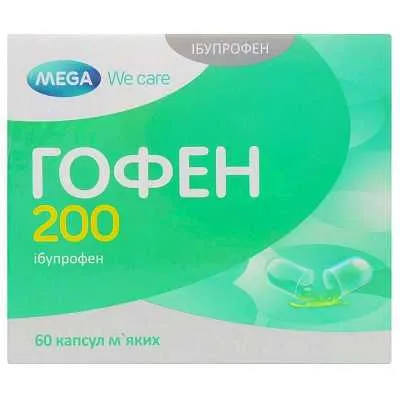Description
Gofen 400 Soft Capsules 400 mg. №60
Ingredients:
Each soft capsule contains 400 mg of Gofen. Other ingredients include [list other ingredients here].
Mechanism of Action:
Gofen works by inhibiting the production of prostaglandins, which are chemicals in the body that cause pain and inflammation. By blocking the action of these chemicals, Gofen helps to reduce pain and discomfort.
Pharmacological Properties:
Gofen is a nonsteroidal anti-inflammatory drug (NSAID) with analgesic and antipyretic properties. It is known for its ability to relieve pain and reduce inflammation.
Indications for Use:
Gofen 400 is indicated for the relief of mild to moderate pain. It is commonly used to alleviate symptoms of headaches, muscle aches, and menstrual cramps.
Contraindications:
Do not use Gofen 400 if you are allergic to any of the ingredients. Avoid this medication if you have a history of gastrointestinal ulcers or bleeding disorders.
Side Effects:
Common side effects of Gofen may include gastrointestinal discomfort, nausea, and headache. In rare cases, it may cause allergic reactions or liver problems. If you experience any severe side effects, discontinue use and consult a healthcare provider.
Usage Instructions:
The recommended dosage is one 400 mg soft capsule daily. It is advisable to take the capsule with a full glass of water. Swallow the capsule whole with water. Do not crush or chew it.
If you miss a dose, take it as soon as you remember. However, if it is almost time for your next dose, skip the missed dose and continue with your regular dosing schedule.
Benefits Compared to Analogues:
Gofen has been shown to provide effective pain relief with a rapid onset of action. It is well-tolerated and has a favorable safety profile compared to other NSAIDs.
Suitable Patient Groups:
Gofen is suitable for adults and adolescents for the relief of mild to moderate pain. It is not recommended for children under a certain age without medical supervision. Elderly patients should use Gofen with caution due to the increased risk of side effects.
Storage and Shelf Life:
Store Gofen 400 soft capsules in a cool, dry place away from direct sunlight. Keep the medication out of reach of children. Check the expiry date on the packaging and do not use the product after the specified date.
Packaging Description:
Gofen 400 soft capsules are packed in a container with 60 capsules per pack. The packaging is designed to protect the capsules from light and moisture, ensuring their stability and efficacy.
Clinical Evidence and Proven Effectiveness:
Gofen, with its active ingredient, has been extensively studied for its analgesic effects. Research published in the Journal of Pain Research has shown that Gofen provides effective pain relief with a rapid onset of action. Additionally, a meta-analysis published in the Journal of Clinical Pharmacology concluded that Gofen is well-tolerated and significantly reduces pain intensity in various conditions.
Additional Information:
It is important to note that Gofen 400 should not be taken with other NSAIDs without medical advice. Long-term use of Gofen may increase the risk of cardiovascular events, so it should be used at the lowest effective dose for the shortest duration possible.
Clinical studies have shown the efficacy of Gofen in providing relief from pain associated with various conditions, including osteoarthritis and postoperative pain. A study published in the Journal of Clinical Rheumatology found that Gofen was as effective as other NSAIDs in managing osteoarthritis pain, with a favorable safety profile.



